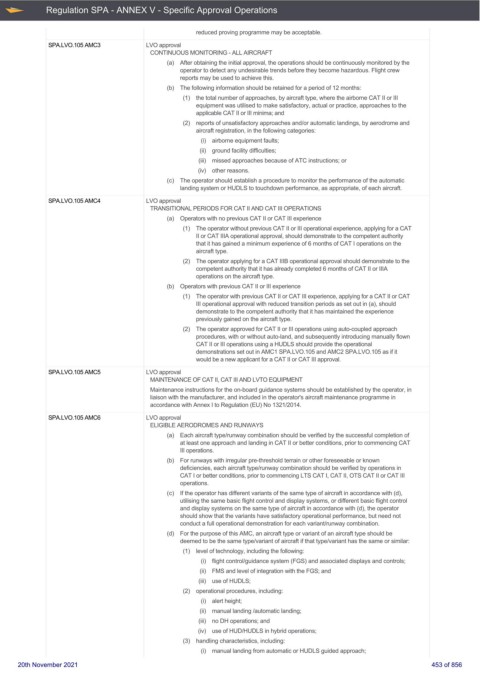Page 453 - UK Air Operations Regulations 201121
P. 453
~
~ Regulation SPA - ANNEX V - Specific Approval Operations Centrik
reduced proving programme may be acceptable.
SPA.LVO.105 AMC3 LVO approval
CONTINUOUS MONITORING - ALL AIRCRAFT
(a) After obtaining the initial approval, the operations should be continuously monitored by the
operator to detect any undesirable trends before they become hazardous. Flight crew
reports may be used to achieve this.
(b) The following information should be retained for a period of 12 months:
(1) the total number of approaches, by aircraft type, where the airborne CAT II or III
equipment was utilised to make satisfactory, actual or practice, approaches to the
applicable CAT II or III minima; and
(2) reports of unsatisfactory approaches and/or automatic landings, by aerodrome and
aircraft registration, in the following categories:
(i) airborne equipment faults;
(ii) ground facility difficulties;
(iii) missed approaches because of ATC instructions; or
(iv) other reasons.
(c) The operator should establish a procedure to monitor the performance of the automatic
landing system or HUDLS to touchdown performance, as appropriate, of each aircraft.
SPA.LVO.105 AMC4 LVO approval
TRANSITIONAL PERIODS FOR CAT II AND CAT III OPERATIONS
(a) Operators with no previous CAT II or CAT III experience
(1) The operator without previous CAT II or III operational experience, applying for a CAT
II or CAT IIIA operational approval, should demonstrate to the competent authority
that it has gained a minimum experience of 6 months of CAT I operations on the
aircraft type.
(2) The operator applying for a CAT IIIB operational approval should demonstrate to the
competent authority that it has already completed 6 months of CAT II or IIIA
operations on the aircraft type.
(b) Operators with previous CAT II or III experience
(1) The operator with previous CAT II or CAT III experience, applying for a CAT II or CAT
III operational approval with reduced transition periods as set out in (a), should
demonstrate to the competent authority that it has maintained the experience
previously gained on the aircraft type.
(2) The operator approved for CAT II or III operations using auto-coupled approach
procedures, with or without auto-land, and subsequently introducing manually flown
CAT II or III operations using a HUDLS should provide the operational
demonstrations set out in AMC1 SPA.LVO.105 and AMC2 SPA.LVO.105 as if it
would be a new applicant for a CAT II or CAT III approval.
SPA.LVO.105 AMC5 LVO approval
MAINTENANCE OF CAT II, CAT III AND LVTO EQUIPMENT
Maintenance instructions for the on-board guidance systems should be established by the operator, in
liaison with the manufacturer, and included in the operator's aircraft maintenance programme in
accordance with Annex I to Regulation (EU) No 1321/2014.
SPA.LVO.105 AMC6 LVO approval
ELIGIBLE AERODROMES AND RUNWAYS
(a) Each aircraft type/runway combination should be verified by the successful completion of
at least one approach and landing in CAT II or better conditions, prior to commencing CAT
III operations.
(b) For runways with irregular pre-threshold terrain or other foreseeable or known
deficiencies, each aircraft type/runway combination should be verified by operations in
CAT I or better conditions, prior to commencing LTS CAT I, CAT II, OTS CAT II or CAT III
operations.
(c) If the operator has different variants of the same type of aircraft in accordance with (d),
utilising the same basic flight control and display systems, or different basic flight control
and display systems on the same type of aircraft in accordance with (d), the operator
should show that the variants have satisfactory operational performance, but need not
conduct a full operational demonstration for each variant/runway combination.
(d) For the purpose of this AMC, an aircraft type or variant of an aircraft type should be
deemed to be the same type/variant of aircraft if that type/variant has the same or similar:
(1) level of technology, including the following:
(i) flight control/guidance system (FGS) and associated displays and controls;
(ii) FMS and level of integration with the FGS; and
(iii) use of HUDLS;
(2) operational procedures, including:
(i) alert height;
(ii) manual landing /automatic landing;
(iii) no DH operations; and
(iv) use of HUD/HUDLS in hybrid operations;
(3) handling characteristics, including:
(i) manual landing from automatic or HUDLS guided approach;
20th November 2021 453 of 856

